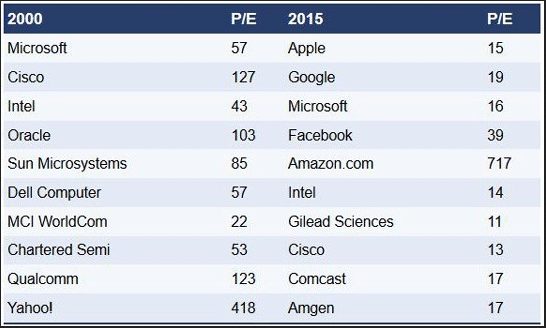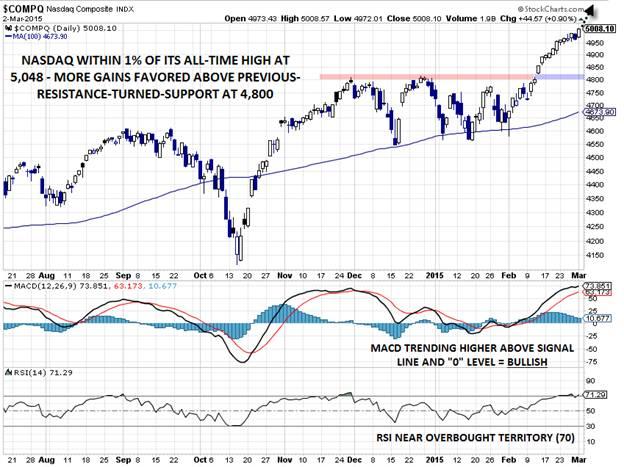![]()
Midway through last month, we highlighted the bullish breakout in the NASDAQ index, concluding that the index, “is starting to look like it may have a date with its all-time highs at 5048 sooner rather than later. As long as the index holds above previous-resistance-turned-support at 4800, the path of least resistance will remain higher†(see “NASDAQ: Party Like it’s 1999!†for more). By now, most Americans have been bombarded with headlines announcing yesterday’s move back above the 5,000 level in the index, leaving the all-time high at 5048 less than 1% away.
In an interesting (some would say ominous) twist of fate, the NASDAQ’s last peak took place on March 10, 2000, almost exactly 15 years ago, and some analysts have argued that the return to the lofty levels of the tech bubble peak is a sign of an imminent top, but the fundamental factors driving the index are far more reasonable this time around:
1) Lack of compelling alternatives: The 10-year US treasury yield is at just 2%, as compared to 6.2% when the NASDAQ last hit 5000 back in 2000.
2) More reasonable valuation: The dearth of compelling alternative investments suggests stocks should be trading at a higher valuation, but the NASDAQ composite is trading at a more reasonable P/E multiple of 31 this time around, versus the preposterous 500 P/E ratio in 2000. The table below shows a “Then and Now†comparison of the P/E ratios of the top 10 stocks in the NASDAQ; with the exception of Amazon, investors are getting far more bang for their buck this time around:
3) Greater sector diversification: The NASDAQ is ubiquitously described as “tech-heavy,†but the index’s tech weighting has actually mellowed substantially over the last 15 years. Technology stocks now represent just 43% of the index, down from 65% in 2000, and the allocation to typically-conservative health care stocks has risen from 7% to 16%.
4) 5,048 is just a nominal high: While the 5,000 level is a psychologically-significant hurdle for the market, there has been plenty of inflation in the last 15 years. To reach a new inflation-adjusted (“realâ€) peak, the NASDAQ would have to rise nearly 40% from here to 6,900.
5) Lack of excessive bullish sentiment: Perhaps most importantly, sentiment is not nearly as frothy as it was back at the peak of the tech bubble. Instead of people quitting their stable jobs to become full-time day traders, the general public remains skeptical of the stock market’s rally, despite massive gains over the last six years. This anecdotal view is supported by the number of new IPOs, which fell from 371 in 1999 to just over 50 last year. Until the public grows euphoric, the chances of a major long-term top are minimal.
While a near-term correction in the NASDAQ is always a possibility, the five fundamental factors noted above suggest that there’s a low probability of a major top forming at this point. From a shorter-term technical basis, the bias in the index will remain higher above previous-resistance-turned-support at 4800, and a breakout to a new all-time high at 5048 could add more fuel to the bullish fire.
This research is for informational purposes and should not be construed as personal advice. Trading any financial market involves risk. Trading on leverage involves risk of losses greater than deposits.
Recommended Content
Editors’ Picks
AUD/USD drops toward 0.6500 after dismal Aussie Retail Sales, mixed China's PMIs

AUD/USD is extending losses toward 0.6500, hit by an unexpected drop in the Australian Retail Sales for March while China's NBS April PMI data came in mixed. Upbeat China's Caixin Manufacturing PMI data failed to lift the Aussie Dollar amid a softer risk tone and the US Dollar rebound.
USD/JPY holds rebound to 157.00 after Monday's suspected intervention-led crash

USD/JPY is trading close to 157.00, staging a solid rebound in the Asian session on Tuesday. The pair reverses a part of heavy losses incurred on Monday after the Japanese Yen rallied hard on probable FX market intervention by Japan's authorities. Poor Japan's jobs and Retail Sales data weigh on the Yen.
Gold prices soften as traders gear up for Fed monetary policy decision

Gold price snaps two days of gains, yet it remains within familiar levels, with traders bracing for the US Fed's monetary policy decision on May 1. The XAU/USD retreats below the daily open and trades at $2,334, down 0.11%, courtesy of an improvement in risk appetite.
BNB price risks a 10% drop as Binance founder and ex-CEO Changpeng Zhao eyes Tuesday sentencing

Binance Coin price is dumping, with the one-day chart showing a defined downtrend. While the broader market continues to bleed, things could get worse for BNB price ahead of Binance executive Changpeng Zhao sentencing on Tuesday, April 30.
FX market still on intervention watch

Asian foreign exchange traders will be particularly attentive to any signs of Japanese intervention on Tuesday, following reports of Tokyo's involvement in the market on Monday. This intervention action propelled the yen upward from its 34-year low of 160 per dollar, setting off shockwaves of volatility.

